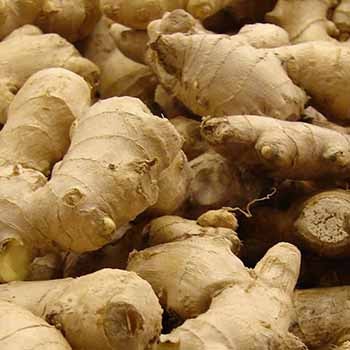
GINGER
Ginger, or zingiber officinale, is a perennial plant having thick branching aromatic rhizomes and leafy reedlike stems. For centuries, ginger has been widely used as a spice throughout the world, especially in Asian countries. A native to China and India, this plant is widely cultivated in Southeast Asia, West Africa, and the Caribbean. It needs a minimum annual rainfall of 150cm, temperatures of 30°C or over, a short dry season and a deep fertile soil. Known for its slightly biting and hot flavour, this spice is widely used in preparing gingerbread, ginger ale, gingersnaps and Asian dishes. It adds delicacy to the dish by its rich, sweet, warm and woody aroma.
Ginger paste in combination with garlic and onion is widely used in preparing almost every meat dish by the Indians and the Pakistanis. It is also used as a flavouring agent to add more warmth in tea. It takes its name from the Sanskrit word stringa-vera, which means “with a body like a horn”, as in antlers.
The pungency in ginger is due to the presence of a volatile oil. The dried rhizome contains approximately 1—3% volatile oil which is the source of ginger’s characteristic aroma; an oleoresin contains the pungent properties.
Spice Description
Often termed as “ginger root”, ginger is actually a rhizome. It is available in the following forms:
Fresh Ginger: The whole raw roots are referred to as fresh ginger. It has a pale yellow interior and a skin varying in colour from brown to off-white. It can be grated, chopped, or julienned for use
Culinary Uses
Ginger is undoubtedly an essential ingredient to Asian and oriental cookery. It is used in pickles, chutneys and curry pastes and the ground dried root is a constituent of many curry powders. It is also used as an flavoring agent in preparing sweet dishes, cakes, cookies, breads, and beverages. Sometimes the roots will produce green sprouts which can be finely chopped and added to a green salad.
Pickled ginger is a delicious accompaniment to satays and a colourful garnish to many Chinese dishes. In the West, the dried ginger is mainly used in preparing confectionery items like biscuits and cakes. It is also used in puddings, jams, preserves and in some drinks like ginger beer, ginger wine and tea.
Medicinal Properties
- Besides being used as a spice, ginger also contains natural healing properties. It has long been ascribed aphrodisiac powers, taken either internally or externally. It is highly effective in treating nausea, motion sickness, morning sickness and general stomach upset. Its anti-inflammatory properties help relieve pain and reduce inflammation associated with arthritis, rheumatism and muscle spasms.
- Ginger root consists of gingerols, zingibain, bisabolenel, oleoresins, starch, essential oil (zingiberene, zingiberole, camphene, cineol, borneol), mucilage, and protein. It contains many therapeutic properties and is highly effective in stimulating the blood circulation, removing toxins from the body, cleansing the bowels and kidneys, and nourishing the skin. Other uses for Ginger Root include the treatment of asthma, bronchitis and other respiratory problems by loosening and expelling phlegm from the lungs.
- Ginger is on the FDA’s ‘generally recognized as safe’ list, though it does interact with some medications, including warfarin. Some studies show ginger may also help prevent certain forms of cancer.